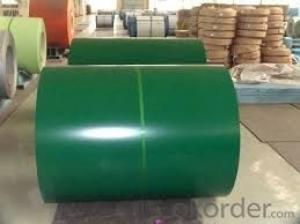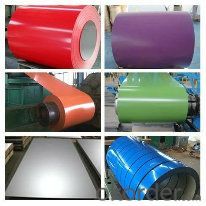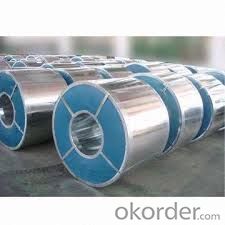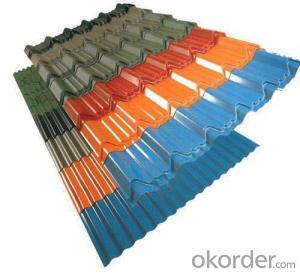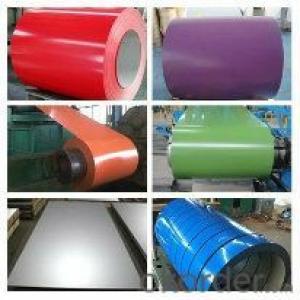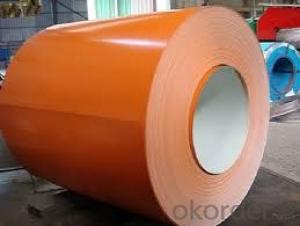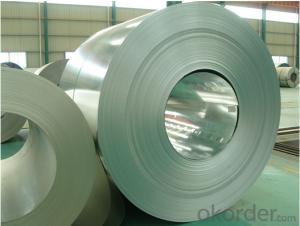Color Steel Color Rolled/ Printed Color Galvanized Steel Coil
- Loading Port:
- Shanghai
- Payment Terms:
- TT OR LC
- Min Order Qty:
- 25 m.t.
- Supply Capability:
- 18000 m.t./month
OKorder Service Pledge
OKorder Financial Service
You Might Also Like
Product Description
Military Printed Color Galvanized Steel Coil
1. Techinical standard: EN10169
2. Grade: TDX51D, TSGCC
3. Color: Ral standard or according to customers' requirment
4. Thickness: 0.14-0.8mm (the most advantage thickness)
5. Width: 600-1250mm (610/724/820/914/1000/1200/1219/1220/1250)
6. Base metal: Galvanized / galvalume steel / cold rolled
7. Finish Painting: 15-20miu PE on top
Back painting: 5-8miu EP on back
8. Type of PPGI: PPGI with military pattern
Product category and properties: The products can be divided into the following sorts in the light of their specific manufacturing and processing methods:
1. Hot-dip galvanized steel coil. Its the most common galvanized steel product at present.
2. Hot-dip galvalume steel coil. Al-Zn galvanized steel sheet. General use, construction industry, household appliance industry, automobile industry and industrial instruments.
3. Color coating steel coil. Any color according to the requests of customers. General use, for drawing, structure, construction industry (outdoor), factory building, agricultural warehouse, prefabricated ports of residence, title roof and furniture appliance.
4. Guardrail. Highway guardrail/fence can be used for both sides of highway and road. Available in any different sizes. Hot-dipped galvanized or galvalume steel sheet. Spraying plastics in your exact specifications.
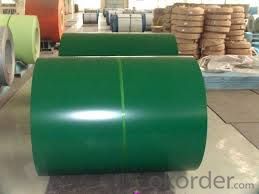
| Back painting: | 5-7 mic. EP |
| Color: | According to RAL standard |
| commodity | Color-coated Galvanized Steel Coil (PPGI/ PPGL) |
| Techinical Standard: | JIS G3302-1998, EN10142/10137, ASTM A653 |
| grade | TSGCC, TDX51D / TDX52D / TS250, 280GD |
| Types: | For general / drawing use |
| Thickness | 0.14-1.0mm(0.16-0.8mm is the most advantage thickness)) |
| Width | Width: 610/724/820/914/1000/1200/1219/1220/1250mm |
| Type of coating: | PE, SMP, PVDF |
| Zinc coating | Z60-150g/m2 or AZ40-100g/m2 |
| Top painting: | 5 mic. Primer + 15 mc. R. M. P. |
| ID coil | 508mm / 610mm |
| Coil weight: | 4--8MT |
| Package: | Properly packed for ocean freight exportation in 20' ' containers |
| Application: | Industrial panels, roofing and siding for painting / automobile |
| Price terms | FOB, CFR, CIF |
| Payment terms | 20%TT in advance+80% TT or irrevocable 80%L/C at sight |
| delivery time | 25 days after recepit of 20% TT |
| Remarks | Insurance is all risks |
| MTC 3.1 will be handed on with shipping documents | |
| We accept SGS certificatation test |
Q&A What is the validity of your quotation?
ANSWER: Normally 2 days
- Q: What are the different methods of punching steel coils?
- There are several different methods used for punching steel coils, depending on the specific requirements and desired outcome. Here are a few common methods: 1. Mechanical Punching: This method involves using a mechanical press to apply force and create holes in the steel coil. It utilizes a punch and die set, where the punch is driven into the coil to create the hole. Mechanical punching is ideal for punching small to medium-sized holes and is often used in high-volume production settings. 2. Hydraulic Punching: Hydraulic punching utilizes hydraulic pressure to drive the punch into the steel coil. This method is often used for punching larger holes or shapes that require greater force. Hydraulic punching machines offer precise control and can handle thicker and harder materials. 3. Laser Cutting: Laser cutting is a non-contact method that uses a laser beam to cut through the steel coil. A focused laser beam is directed onto the coil, melting and evaporating the material to create the desired shape or hole. Laser cutting offers high precision and can be used for complex shapes and patterns. 4. Plasma Cutting: Plasma cutting involves using a high-velocity jet of ionized gas (plasma) to melt and remove the steel coil material. This method is suitable for cutting thicker steel coils and is often used for larger holes or irregular shapes. 5. Waterjet Cutting: Waterjet cutting utilizes a high-pressure jet of water mixed with abrasive particles to cut through the steel coil. This method is versatile and can effectively cut through various materials, including steel. Waterjet cutting is known for its high precision and clean cuts. Each method of punching steel coils has its own advantages and considerations. Factors such as material thickness, desired precision, production volume, and cost will determine the most suitable method for a specific application.
- Q: does anyone out there know where to get a good deal on a pedal steel guitar? i am from northern indiana and i'm willing to travel some if i have to.i am just getting into pedal steel guitar and i really don't have any idea what i need. i don't know how to play a guitar (i do know how to play the piano and the drums) at all but i want to learn to play the pedal stell guitar and i can't do that without getting one first so, if anyone can help me out i would greatly appreciate it! :o)
- I agree with everything that Lester said. Another thought is to consider starting on a lap steel guitar rather than a pedal steel - its related, a little easier to learn on, and less expensive. Once you get proficient on the lap steel, you can move up to the pedal steel. Good luck!
- Q: How is the critical temperature of structural steel affected by fireproofing? What temperatures can fireproofed structural steel withstand?
- This would depend upon the method of fireproofing. Steel used to be insulated with an asbestos coating. Of course the steel under the insulation had the same critical temperature as the uncoated steel but was protected from external heat by the insulation. More commonly it would be an alloy and there are so many that one could not guess except to say it should be higher than the original.
- Q: What is the difference between cold rolled strip and cold rolled steel coil?
- Single literal explanation, volume and band are different, appearance shape is not the same.
- Q: What are the common methods of painting or coating steel coils?
- One common method of painting or coating steel coils is through the process of coil coating. In coil coating, the steel coils are first cleaned and pre-treated to remove any contaminants and improve adhesion. Then, a primer or a base coat is applied to the coils to provide a foundation for the final coating. This primer helps in protecting the steel from corrosion and improves the overall durability of the coating. After the primer is applied, the steel coils pass through a series of rollers where the topcoat is applied. The topcoat can be a variety of materials such as polyester, polyurethane, or fluoropolymer, depending on the desired properties of the final coating. These topcoats provide the desired color, gloss, and protection against weathering, chemical exposure, and UV radiation. Another common method of painting or coating steel coils is through the process of electrostatic spraying. In this method, a paint or coating material is atomized into fine droplets and then charged with an electrical charge. The steel coils, which are grounded, attract the charged droplets, resulting in an even and controlled application of the paint or coating material. Powder coating is yet another method used for painting or coating steel coils. In this process, a dry powder is electrostatically charged and sprayed onto the steel coils. The charged powder adheres to the surface of the steel due to electrostatic attraction. The coated steel coils are then heated, causing the powder to melt and form a continuous film, providing a durable and resistant coating. Overall, these methods of painting or coating steel coils offer a wide range of options in terms of color, finish, and performance characteristics. The choice of method depends on factors such as the desired appearance, level of protection needed, and the specific requirements of the intended application.
- Q: What are the different types of steel coil surface finishes?
- There are several different types of steel coil surface finishes available, each with its own unique characteristics and applications. Some of the most common types include: 1. Hot rolled: This finish is achieved by rolling the steel at a high temperature, which results in a rough and textured surface. Hot rolled steel coils are commonly used in applications where aesthetics are not a priority, such as structural or industrial projects. 2. Cold rolled: In contrast to hot rolled steel, cold rolled steel coils are processed at lower temperatures, resulting in a smoother and more refined surface. This finish is ideal for applications where a clean and polished appearance is desired, such as automotive parts, appliances, and furniture. 3. Galvanized: Galvanized steel coils are coated with a layer of zinc to protect them from corrosion. This finish provides excellent resistance to rust and can be used in a variety of outdoor applications, including roofing, fencing, and signage. 4. Stainless steel: Stainless steel coils have a unique finish that is resistant to corrosion, staining, and rust. This makes them highly versatile and suitable for a wide range of applications, including kitchen appliances, medical equipment, and architectural projects. 5. Coated: Coated steel coils are treated with a protective layer of paint or other coatings to enhance their durability and aesthetic appeal. This finish is commonly used in the construction industry for applications such as roofing, siding, and garage doors. 6. Pre-painted: Pre-painted steel coils are coated with a layer of paint or resin before they are formed into the final product. This finish offers a wide range of colors and finishes, making it popular for applications such as building cladding, appliances, and automotive parts. Overall, the choice of steel coil surface finish depends on the specific requirements of the project, including aesthetics, corrosion resistance, and durability. Each finish has its own advantages and disadvantages, and it is important to consider these factors when selecting the appropriate type of steel coil surface finish for a particular application.
- Q: What is the role of steel coils in the production of conveyors?
- Steel coils play a crucial role in the production of conveyors as they are used to create the framework or structure of the conveyor belts. The coils are formed into a continuous loop, which provides strength, durability, and flexibility to the conveyor belts. Additionally, the steel coils ensure smooth movement and support heavy loads, making them essential components in conveyor manufacturing.
- Q: Is there a difference between hot rolled and cold rolled steel coils?
- Yes, there is a significant difference between hot rolled and cold rolled steel coils. Hot rolled steel coils are produced at high temperatures and are typically used for applications that require malleability and ductility. On the other hand, cold rolled steel coils are produced at room temperature and undergo a process that results in a smoother, more precise finish. Cold rolled steel coils are often used in applications that require a higher degree of strength and surface quality.
- Q: How do steel coils contribute to the manufacturing of HVAC systems?
- Steel coils are used in the manufacturing of HVAC systems primarily for their strength and durability. They form the core structure of various components such as heat exchangers, condenser coils, and evaporator coils. The steel coils provide stability and support, ensuring the longevity and efficiency of HVAC systems by withstanding high temperatures, pressure, and constant use.
- Q: What are the different steel coil packaging methods?
- There are several different steel coil packaging methods, including using steel strapping, wrapping with plastic or stretch film, placing the coils in wooden crates, or using steel coil sleeves or eye-to-sky packaging.
Send your message to us
Color Steel Color Rolled/ Printed Color Galvanized Steel Coil
- Loading Port:
- Shanghai
- Payment Terms:
- TT OR LC
- Min Order Qty:
- 25 m.t.
- Supply Capability:
- 18000 m.t./month
OKorder Service Pledge
OKorder Financial Service
Similar products
Hot products
Hot Searches
Related keywords
